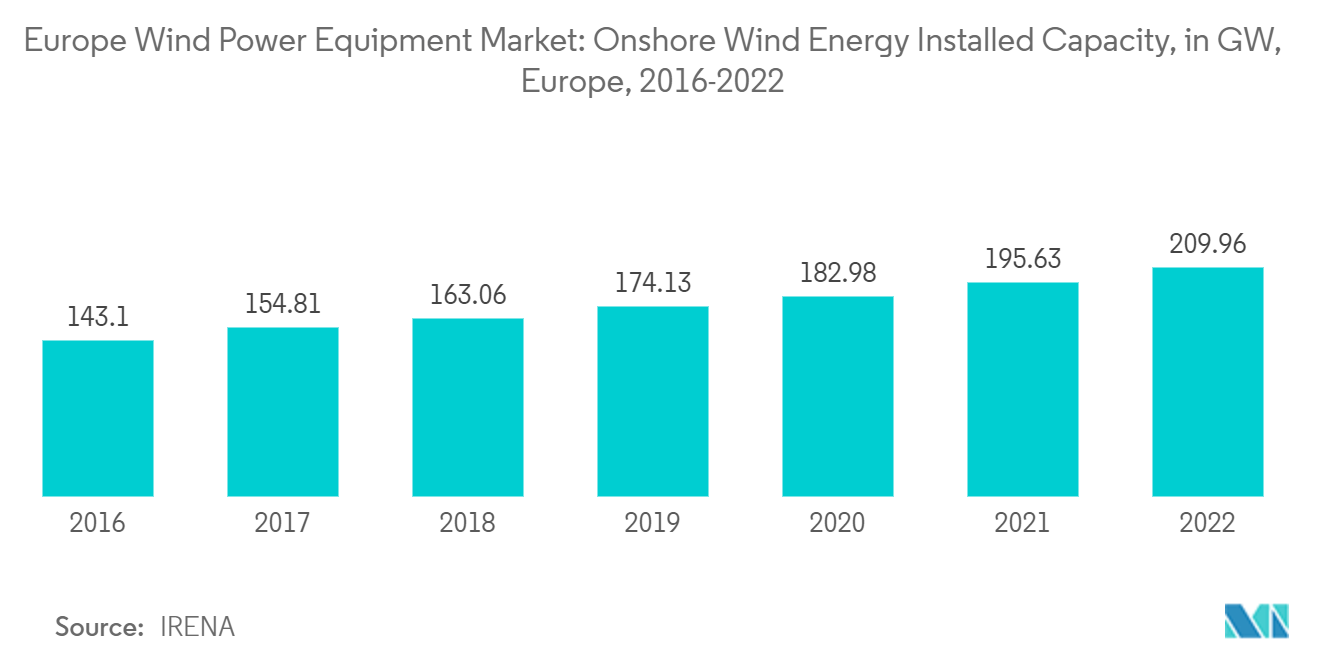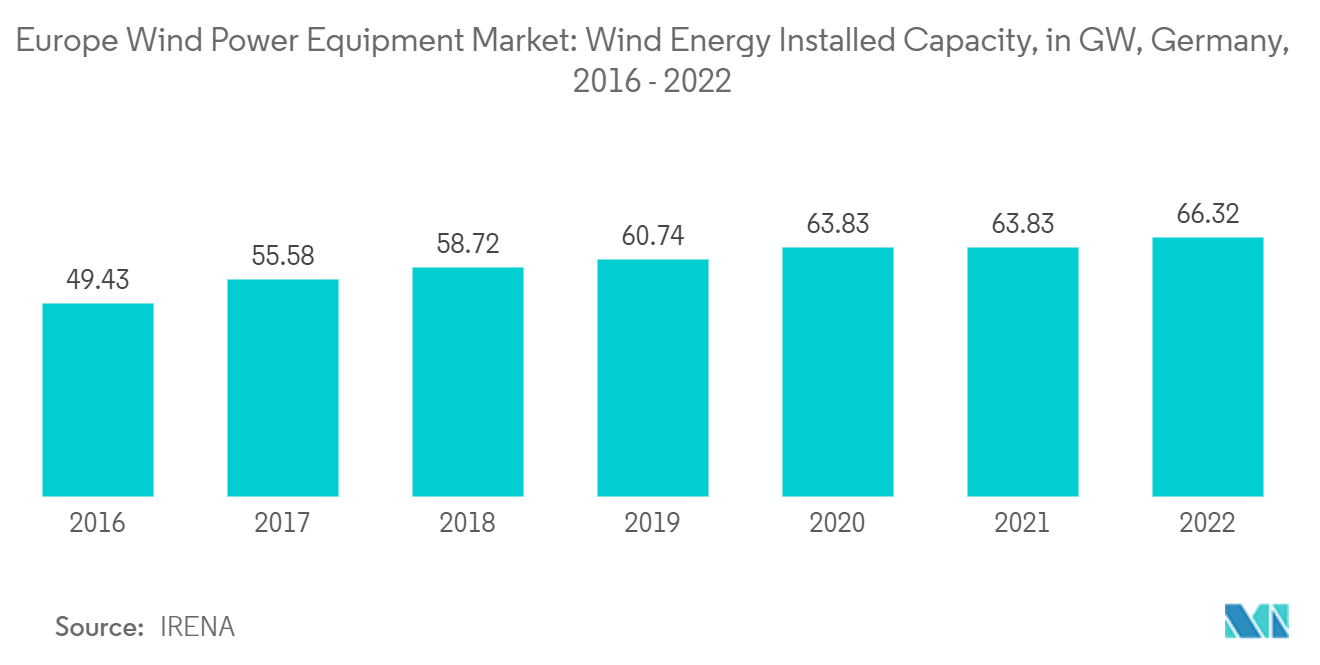Market Trends of Europe Wind Power Equipment Industry
Onshore Segment to Dominate the Market
- Onshore wind power is made by turbines that are on land and get their power from the wind.Most of Europe is made up of onshore wind farms because they are cheaper, there isn't much land there, and places like Northern Germany have high-speed winds.
- By changing the way wind turbines are built, new types of onshore turbines are being put on the market to make wind energy more efficient. Additionally, the size and height of wind turbines have been continuously increasing, lowering installed costs and the levelized cost of electricity and driving the market's growth.
- For example, in April 2022, Vestas released the 7.2 MW V172, which at the time was the world's largest onshore wind turbine. It was made for low and medium wind speeds in a wide range of places. The blades of the turbine are all one piece and are 84 meters long. To go with the turbine, an onshore wind turbine tower with a hub height of 199 meters was launched. The company says that the tower was made with Central European markets like Germany and Austria in mind. Installations will be available in 2025.
- The countries in the region are expanding their presence in the wind energy sector and eliminating the use of coal to generate electricity. The countries are helping to develop numerous new projects to fulfill the increased demand for energy. For Instance, in February 2024, The European Investment Bank (EIB) agreed to provide supportive credits worth EUR 36 million for the development of a 50 MW wind farm on the high plateau of the Vlas̯ić mountain, which is situated around 15 km to the northwest of Travni town. The project, which is planned to generate 115 GWh of electricity annually, is in line with national strategies for renewable energy and has up to 18 wind turbines connected to the national energy grid.
- Similarly, in December 2023, Masdar increased its presence in Europe by acquiring Poland's 1GW renewable portfolio. The agreement represents a significant increase in Masdar's portfolio of renewable energy throughout Europe. Between 2026 and 2030, projects in Poland are anticipated to be completed, with a combined capacity exceeding 1GW. To optimize grid allocation, a hybrid system comprising onshore wind and solar photovoltaic (PV) will be operated on eight sites. All these types of projects are likely to increase the demand for Onshore wind energy projects across the region during the forecast period.
- According to the International Renewable Energy Agency (IRENA), Onshore installed wind capacity increased to 209.96 GW in 2022, rising by nearly 7.3% from 195.63 GW in 2021. Also, as of 2022, Europe had more than seven times as much installed onshore wind capacity as offshore wind capacity. During the forecast period, the installed capacity is expected to go up even more because investments are going up.
- So, the market for onshore wind power equipment is likely to grow a lot over the next few years, thanks to more investments, tax breaks, and technological advances.

Germany to Dominate the Market
- According to the International Renewable Energy Agency (IRENA), The installed wind energy capacity in the country increased by 3.89%, from 63,833 megawatts in 2021 to 66,315 megawatts in 2022. New wind projects are being installed in the country, which is expected to boost the wind power equipment market.
- Due to the government's plan to cut taxes, Germany's wind energy industry has grown a lot in the past ten years. The impact of the Russia-Ukraine war has been significant, and the country's energy prices have skyrocketed as a result of the suspension of Russian gas imports.To reduce overdependence on Russian gas imports, the country has set a target of an 80% share of renewables in electricity by 2030 and a completely climate-neutral energy system by 2045.
- In July 2022, the German Parliament adopted a new onshore wind law (WindLandG), which aims to expand onshore wind by a massive 10 GW a year from 2025. Additionally, the federal government has mandated that all states set aside 2% of their territory for onshore wind generation, which is to be achieved by 2032. Additionally, in the offshore wind sector, Germany aims to reach 30 GW of offshore wind by 2030 and raise it to 70 GW by 2045.
- Due to the fast growth of renewable energy, the number of new wind projects planned in the country has gone up by a lot.For example, Vattenfall got the right to build the N-7.2 offshore wind power project in the German North Sea in September of 2022.The wind farm is expected to be commissioned in 2027 and will have an output of 980 MW.
- The demand for renewable energy in Germany is increasing exponentially, and the country is focusing on increasing its energy reserves for the upcoming year. For Instance, In January 2024, Germany's Federal Network Agency launched a project for two North Sea sites with the ability to accommodate 2.5 GW of wind energy capacity. The two locations, located approximately 120 kilometers (74.56 miles) northwest of Heligoland, can accommodate wind turbines with capacities of 1.5 CW and 1 GW. The wind farms are projected to be operational by 2031.
- Similarly, In March 2023, Germany's Federal Network Agency announced a new offshore wind project to install 1.8 GW of offshore wind generating projects in the North Sea at four locations, with grid connection scheduled for 2028. Two are located around 35 kilometers north of Nordine and have a total generation capacity of 900 megawatts. The other two are 90 kilometers northwest of Borkum and are expected to have a generation capacity of 900 MW. All these projects create opportunities for the market payers and increase the demand for Wind Power Equipment in the region during the forecast period.
- Hence, Germany is expected to dominate the European wind power equipment market due to the significant scale of investments and a plausible tax incentive for the sector.


